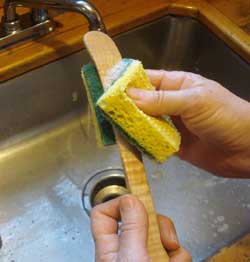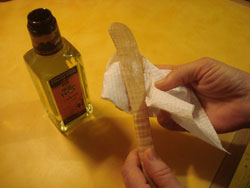Questions? Orders? Contact Us!
WOODENWARES CARE
|
|
You really CAN keep them as lovely-looking and feeling as the day they were first finished.
All wood gains a distinctive patina over time. That's part of its charm. We use Meb’s grandmother’s spoons and cutting boards daily. With proper care, your woodenwares should shine for many generations. Never put woodenwares in a dishwasher. Heat and water are enemies of wood. (Ken, below, was just lucky.) |
Big Board CareLarge, one-piece boards, even after drying may be susceptible to slight warping due to the uneven distribution of moisture. To fix this: Stand the board on edge leaning against a wall to allow the moisture to equalize on both sides. Turn it over, and flip top to bottom a few times. This may take a few days. To prevent this: When the board is lying flat on a counter top flip it over occasionally, especially after you wipe it (unequal moisture). I put a knife under one edge overnight just to allow air circulation, or store on edge.
Mineral OilcWe’re often asked why we don't use mineral oil on our work. So here's another quote -- from Prevention Magazine.
"Q. What is mineral oil? Does it have any nutritional value? Is it safe to use? A. Mineral oil is a chemical byproduct of petroleum manufacturing. Sound unappetizing? Good. You should never ingest mineral oil -- either as a laxative or by cooking with it. Granted, it's still on the market as an ingredient in some laxatives. But many doctors and nutritionists condemn its use. And well they should. It works by coating food particles and the intestinal walls so that food literally slides out of the system -- without much nutrition being absorbed. Also, mineral oil dissolves vitamins A, D, E and K, as well as some essential fatty acids. And, in spite of its name, it provides no minerals -- or any other nutrients." Also, it seems that mineral oil sits on top of the wood grain, instead of penetrating and protecting the grain. |
How to Season WoodMy quick version: Under 5 minutes working time! After washing a bunch of times, wood gets that fuzzy-feeling.
1. Use a soapy green scrubby (in the sponge section at the grocery) to clean. Rinse. 2. Towel off, then let air dry. 3. Use a dry scrubby to remove the leftover fuzz. Rub in the direction of the grain (along the lines) so you don't make scratches. 4. Then rub on your choice of oil, let it penetrate, wipe off well and let air dry overnight. Do this whenever wood gets fuzzy or dull-looking. If wood is smooth and shiny, then you can dish out blueberry pie or borsht with no worries! Recommended Oils : In the workshop, I use a pure boiled linseed oil, and now you can too by clicking the link! Unlike the stuff from the hardware store, this has no chemical dryers. At home, I sometimes use walnut oil (available in the salad oil section in most groceries) If you don’t have nut allergies, nut oils work best since, like the linseed oil, they harden. If nuts are on your Forbidden Food List, canola and grapeseed oils are my other favorites. Olive oil tends to darken the woods and can get a bit sticky. If you STAIN your wooden pieces, sometimes you can remove the stain with a gritty liquid cleanser. Rub on the cleanser in the direction of the grain. Rinse well, then start over again with the seasoning process. If you have the patience and want an impenetrable hand-rubbed finish with a deep-down luster, do the following: Put oil on the wood. Rub briskly with your hands till the wood heats up. That helps the oil penetrate into the grain. Keep rubbing. More. Add a little oil. Keep rubbing. More. And even More. Prop it up to harden. The old saying about this finish is Once a day for a week Once a week for a month Once a month for a year Once a year forever AN ASIDE...
TO: Whom It May Concern FROM: Ken L, Pomfret, CT "I purchased a set of tongs from Meb's Kitchenwares about 6 years ago and just found out from Meb and Tom that I was not supposed to wash them in the dishwasher. Anyway, I have been, and they are still as good as they were when I first got them. I am guessing I use them about 3 times a week, therefore, they're in the dishwasher 3 times a week." Ken L and Jeannie S, Pomfret, CT
|
Germs
People often ask about germs and wood. Here's a quote from one of our favorite books:
"It was once believed that nylon or plastic cutting boards were preferable to the wooden variety. Since then, research has indicated that wood is probably better after all. Researchers have discovered that when cutting boards are contaminated with organisms that can cause food poisoning, almost all the bacteria on the wooden boards die off within three minutes, |
while almost none die on the plastic ones. For added security, you can wash your wooden cutting board periodically with hydrogen peroxide and water or a bleach-and-water solution. The ideal solution is to use one cutting board exclusively for vegetables and one for meat." From Prescription for Nutritional Healing, Balch & Balch, Third Edition, 2000, page 384 NOTES: 1. Diluted vinegar works well, too. 2. Sea Salt rubbed into a board with half a lemon works well, and makes your hands smell great, too. |



